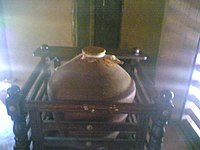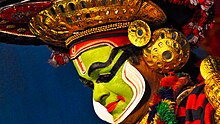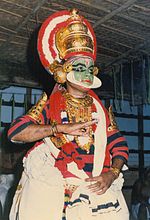Koodiyattam
This article needs additional citations for verification. (November 2019) |
| Koodiyattam | |
|---|---|
Sangam era |
| Kutiyattam, Sanskrit theatre | |
|---|---|
| Country | India |
| Domains | Performing arts |
| Reference | 00010 |
| Region | Asia and the Pacific |
| Inscription history | |
| Inscription | 2008 (3rd session) |
| List | Representative |
Koodiyattam (
Origin

Koodiyattam, meaning "combined acting" in
Ancient kings are among those listed as authors of works for these services. There is evidence of these across the ancient subcontinent during the Chola and Pallava periods. A Pallava king called Rajasimha has been credited with authoring the play Kailasodharanam in Tamil, which has the topic of Ravana becoming subject to Siva's anger and being subdued mercilessly for this.
It is believed that

Instruments

Traditionally, the main musical instruments used in koodiyattam are the
Performance style

Traditionally, koodiyattam has been performed by
The main actor is a Chakyar who performs the ritualistic koothu and koodiyattam inside the temple or in the koothambalam. Chakyar women,
The elders of the Chakyar community traditionally taught the artform to their youngsters. It was performed only by Chakyars until the 1950s. In 1955, Guru Mani Madhava Chakyar performed Kutiyattam outside the temple for the first time,[4] for which he faced many problems from the hardline Chakyar community. In his own words:
My own people condemned my action (performing Koothu and Kutiyattam outside the precincts of the temples), Once, after I had given performances at Vaikkom, they even thought about excommunicating me. I desired that this art should survive the test of time. That was precisely why I ventured outside the temple.[5]
In 1962, under the leadership of art and Sanskrit scholar V. Raghavan, Sanskrit Ranga of Madras invited Guru Mani Madhava Chakyar to perform koodiyattam in Chennai. Thus for the first time in history koodiyattam was performed outside Kerala.[6][7] They presented over three nights koodiyattam scenes from the plays Abhiṣeka, Subhadrādhanañjaya and Nāgānda.[8]

In early 1960s Maria Christoffer Byrski, a Polish student doing research in Indian theatres at Banaras Hindu University, studied koodiyattam with Mani Madhava Chakyar and became the first non-Chakyar/nambiar to learn the art form. He stayed in Guru's home at Killikkurussimangalam and studied in the traditional Gurukula way.[citation needed]
Noted artists



- Mani Madhava Chakyar[9]
- Ammannur Madhava Chakyar, who in the 1980s became one of the first koodiyattam performers to present this art to an international audience.
- Moozhikkulam Kochukuttan Chakyar, who in 1981 became the first Residential Guru at Margi, an institution promoting traditional art forms of Kerala. He was a cousin of Ammannur Madhava Chakyar.
- Mani Damodara Chakyar, who is Mani Madhava Chakkiar's disciple and nephew, is also a performer of traditional devotional koodiyattams.
Decline
Koodiyattam traditionally was an exclusive art form performed in special venues called koothambalams in Hindu temples and access to these performances was restricted to only caste Hindus. Also, performances can take up to forty days to complete. The collapse of the feudal order in the nineteenth century in Kerala curtailed the patronage of koodiyattam artists, and they faced serious financial difficulties. Following a revival in the early twentieth century, Koodiyattam is once again facing a lack of funding, leading to a crisis in the profession.
See also

References
- ^ "UNESCO – Kutiyattam, Sanskrit theatre". ich.unesco.org. Retrieved 21 February 2022.
- ^ Shulman, David. "Creating and Destroying the Universe in Twenty-Nine Nights". The New York Review of Books. Retrieved 9 December 2012.
- ^ "All at home". The Hindu. 13 July 2012.
- ISBN 81-86365-78-8, archived from the originalon 15 February 2008
- ^ Mani Madhava Chakkyar: The Master at Work, K.N. Panikar, Sangeet Natak Akademi New Delhi, 1994
- ^ The Samskrita Ranga Annual, Samskrita Ranga, Madras, 1963, p. 89
- ^ Venkatarama Raghavan, A. L. Mudaliar (1968), Bibliography of the Books, Papers & Other Contributions of Dr. V. Raghavan, New Order Book Co., India, p. 370
- ^ The Samskrita Ranga Annual, Samskrita Ranga, Madras, 1967, p. 77
- Kavalam N. Panikar, Sangeet Natak Akademi, New Delhi, 1994.
- ^ "Kutiyattam, Sanskrit theatre".
- ^ "Welcome to margitheatre".
- ^ "Koodiyattom festival begins at Moozhikulam – The Hindu". The Hindu. 30 July 2012.
- ^ "SNA: List of Akademi Awardees". Sangeet Natak Akademi Official website. Archived from the original on 31 March 2016.
- Chakiar, Mani Madhava (1975), Nātyakalpadrumam, Sangeet Natak Akademi, New Delhi
- Raja, Kunjunni (1964), An Introduction to Kutiyattam, Sangeet Natak Akademi, New Delhi
- Mani Madhava Chakyar: The Master at Work, Sangeet Natak Akademi, New Delhi
Further reading

- Kerala Sahitya Academy Award-winning book on Koodiyattam written by Guru Mani Madhava Chakyar, considered authoritative by scholars.
- The Sanskrit theatre of the Gupta Empire; Koodiyattam is believed to preserve some aspects of the performance style of that period.
- Abhinaya Darpana by Nandikeshvara, another work of dramatic theory comparable to the Nātya Shāstra.
- Farley Richmond, Kutiyattam: Sanskrit Theater of India (University of Michigan Press, 2002). CD-ROM featuring videos and text.
- Rajendran C, "The Traditional Sanskrit Theatre of Kerala" (University of Calicut,1989)
- Virginie Johan, "Kuttu-Kutiyattam : théâtres classiques du Kerala". Revue d’histoire du théâtre 216, 2002-4: 365–382.
- Virginie Johan, "Pour un théâtre des yeux : l’exemple indien". Coulisses 33, 2006 : 259–274.
External links
- Wikiquote:Guru Mani Madhava Chakyar/Kutiyattam
- Kudiyattam: A Multi-Disciplinary Approach to the Living Sanskrit Theater of Kerala
- Shulman, David (24 November 2012), "Creating and Destroying the Universe in Twenty-Nine Nights", The New York Review of Books

